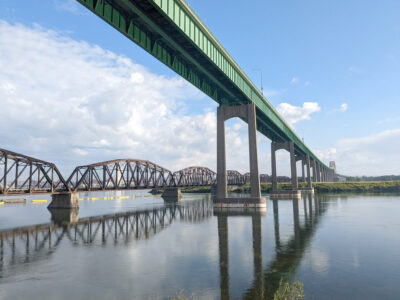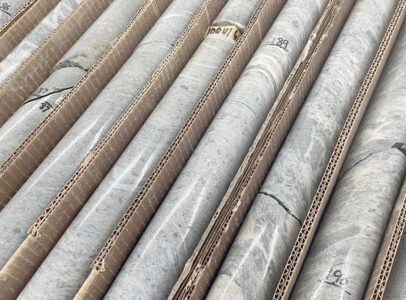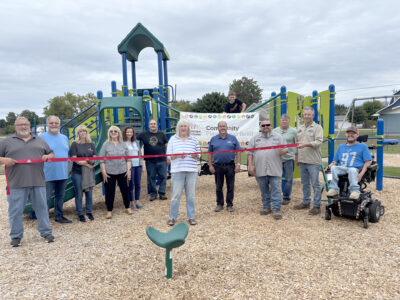Mining company: Drilling confirms ‘significant’ copper, gold in northern Wisconsin

Cores drilled during exploration of the Bend deposit in northern Wisconsin. These cores do not contain metals like copper, but Green Light Wisconsin said testing of cores from drillholes has confirmed significant copper and gold. (Photo courtesy of Steve Donohue/Green Light Wisconsin)
Canadian mining company GreenLight Metals announced Monday that early drilling results confirm the presence of significant copper and gold at the Bend deposit in northern Wisconsin.
The company, which does business in the state as Green Light Wisconsin, drilled six holes this summer on less than an acre of the deposit in Taylor County within the Chequamegon-Nicolet National Forest. The Bend deposit is believed to contain about 4.2 million tons of ore that has primarily copper-bearing sulfides and gold.
Green Light is leasing mineral rights from the Soo Line Railroad to explore a 40-acre parcel on land owned by the U.S. Forest Service. The company said early results confirm high-grade copper with significant gold and tellurium, a rare metalloid used in electronics and the manufacture of solar panels.
The company has completed testing cores from three holes, and results are expected within the next three to four weeks on cores from the remaining three drillholes. The cores are crushed up and analyzed for its copper, gold and tellurium content.
Steve Donohue, a director on the mining company’s board, said early results are exciting and encouraging. He said the company has been testing areas that haven’t been previously drilled.
“We’re seeing evidence of extended mineralization in these areas,” Donohue said. “We’re not at the point where we can say we’ve got an economic deposit that could be developed. We’ll still have to go through more rounds of drilling to get there.”
The findings are very preliminary, said Dave Blouin, mining committee chair for Sierra Club’s Wisconsin Chapter.
“This drilling and future drilling might make the deposit bigger, or it might confirm that it’s actually a very small and uneconomic deposit,” Blouin said.
Blouin noted that Green Light is the third company to explore the deposit. Until this summer, the site hadn’t been explored since 2012 when Aquila Resources conducted drilling. Prior to that, Jump River Joint Venture drilled the deposit in the early 1990s.
Mining hasn’t advanced previously because the Bend site hasn’t been considered economically viable for mining, Blouin said.
“They make it sound like they hit one slightly bigger zone of mineralization, but the key thing to remember about all of these boreholes is that they’re a very small fraction of the total deposit,” Blouin said. “There can be wide variability in the metal content in these deposits.”
Green Light would determine whether the deposit may be economically mined through future drilling that seeks to increase estimates of the tonnage and grade of metal within the deposit.
“That’ll probably include drilling beyond what we’ve currently got planned for the initial part of next year,” Donohue said. “Once we get to the point where we’ve increased the tonnage and the grade, then we’ll start doing engineering and economic analysis. That’s going to depend on how we decided to develop it (and) process it.”
Green Light plans to drill another 15 holes as early as this winter. The company has applied for a prospecting permit from the Bureau of Land Management. The Chequamegon-Nicolet National Forest is reviewing the permit because drilling would occur on Forest Service lands.
Federal agencies have been directed to speed up permitting under the National Environmental Policy Act, but environmental groups have called for an environmental assessment. The Forest Service and Bureau of Land Management have previously said they would decide the appropriate level of review under federal environmental law.
Donohue said he expects federal agencies to wrap up their review yet this year, and the company plans to submit a notice of intent to drill with the state Department of Natural Resources in the coming months.
Neither the DNR nor the Forest Service immediately responded to requests for comment Monday.
The company spent just short of $1 million on its first phase of drilling, Donohue said. More than $8 million has been invested in exploration of the site to date, which has included drilling of 59 holes.
The Lac du Flambeau Band of Lake Superior Chippewa had sued the DNR to bar the agency’s decision to grant a general construction site permit for drilling. A Taylor County judge denied the tribe’s request that the company obtain an industrial permit due to concerns that drilling would damage the environment and cultural resources. The case is still ongoing, and the Ho-Chunk Nation has sought to intervene.
A spokesperson for the Lac du Flambeau tribe didn’t immediately respond to a request for comment Monday. Ojibwe tribes want regulators to require future drilling in frozen conditions to minimize harm to wetlands on the site.






